
Car centric road design requires a tremendous amount of parking, but what if this public space was used for something else? Each year in cities across the world, people come together to reimagine street parking into safe and inviting pedestrian spaces. The Council and its pedestrian advocacy group Feet First Philly are long time participants in this international celebration, and this year the Council’s team turned a parking space on the 1800 block of Chestnut St. into a temporary parklet where people walking by could try their hand at redesigning a city street with an interactive game. Check out these photos from our parklet in Center City, Philadelphia.

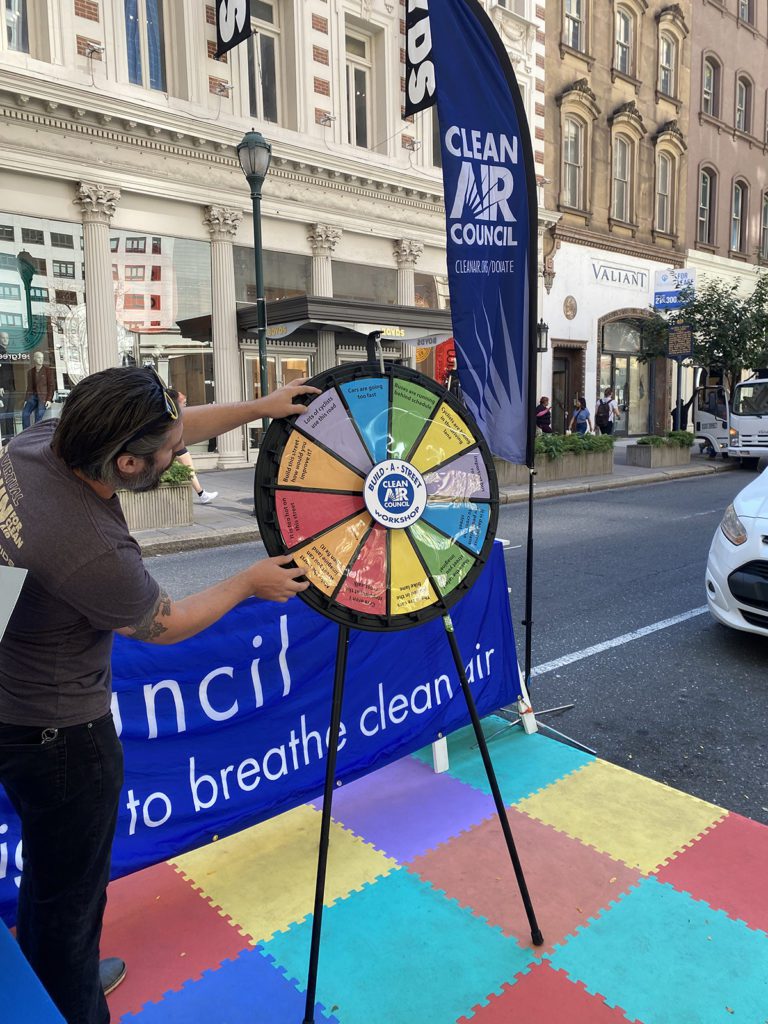
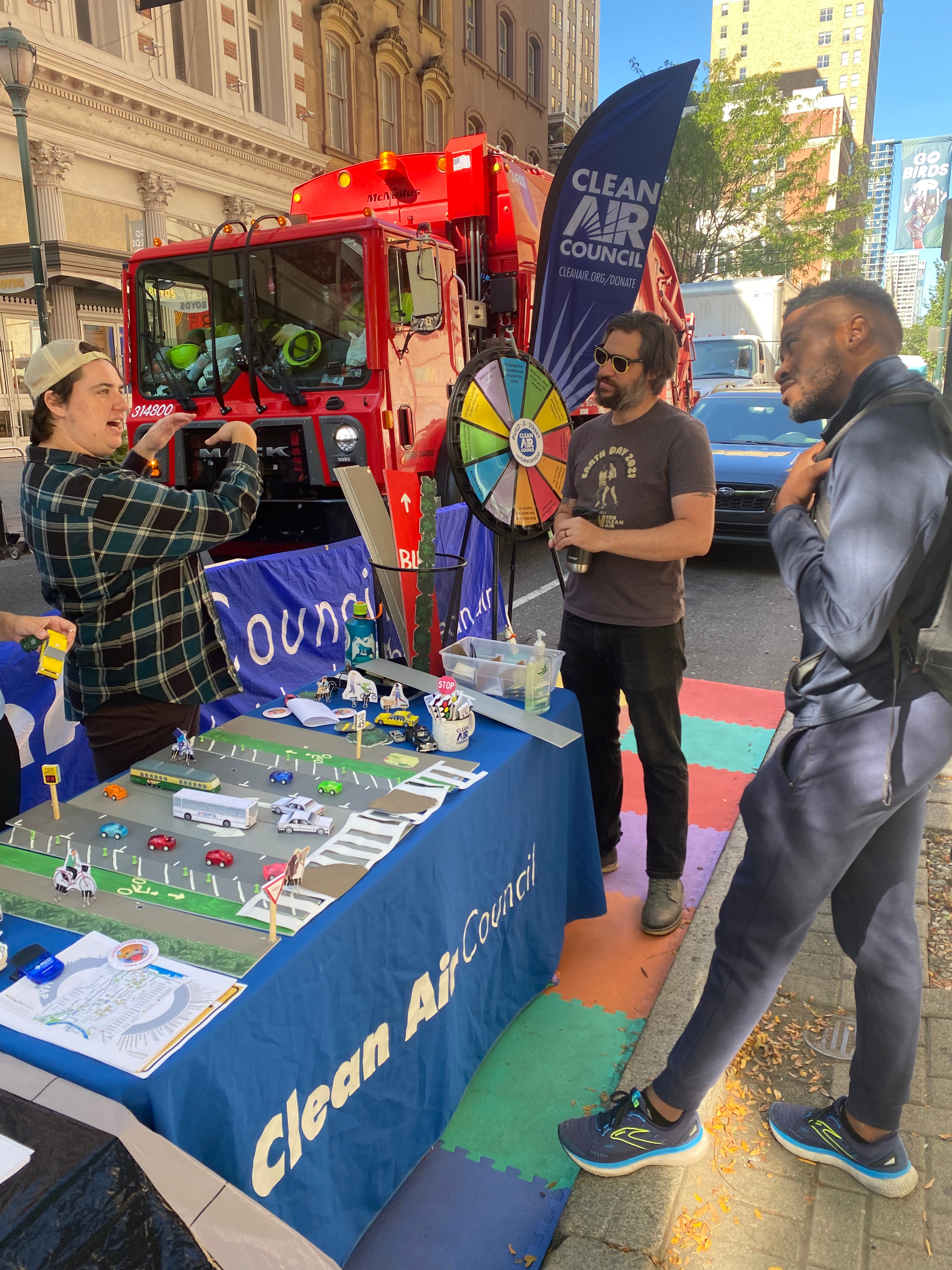
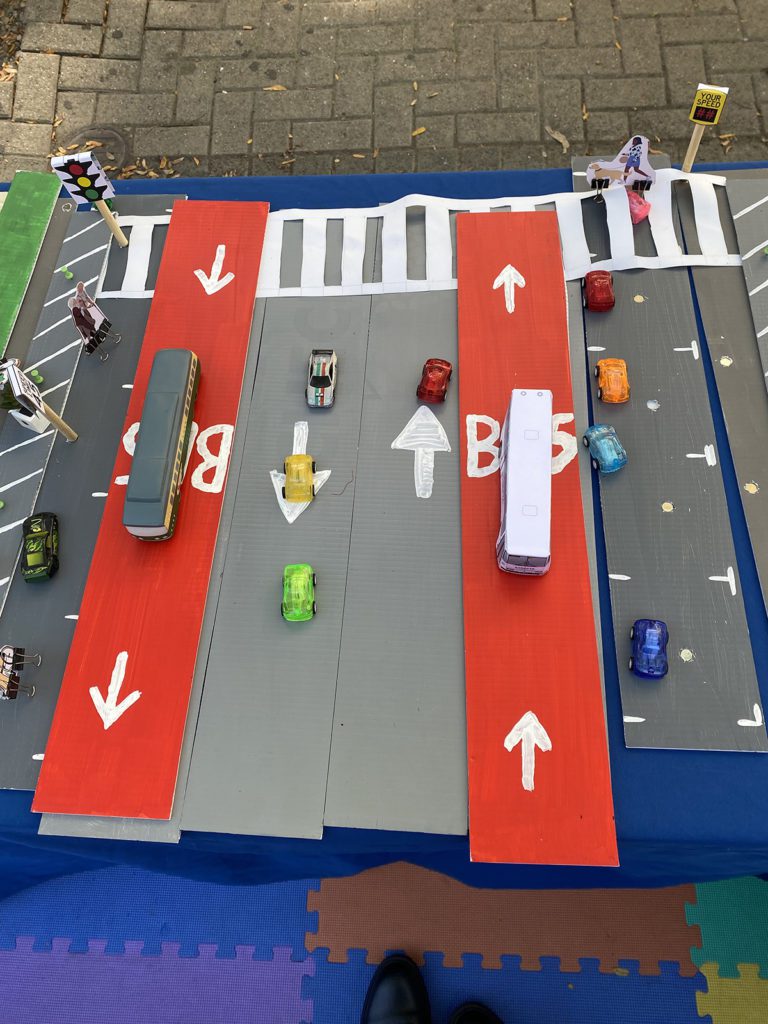
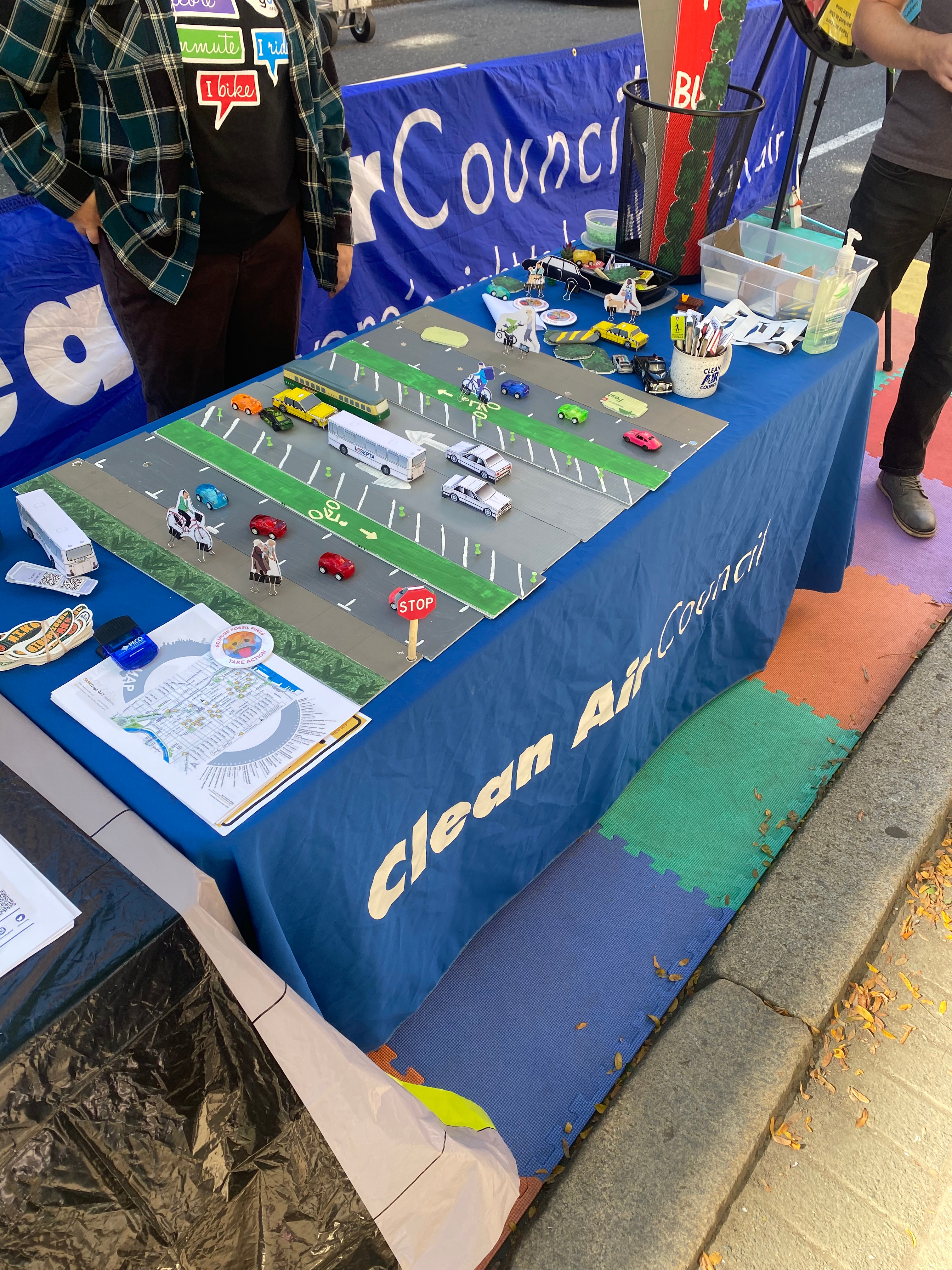

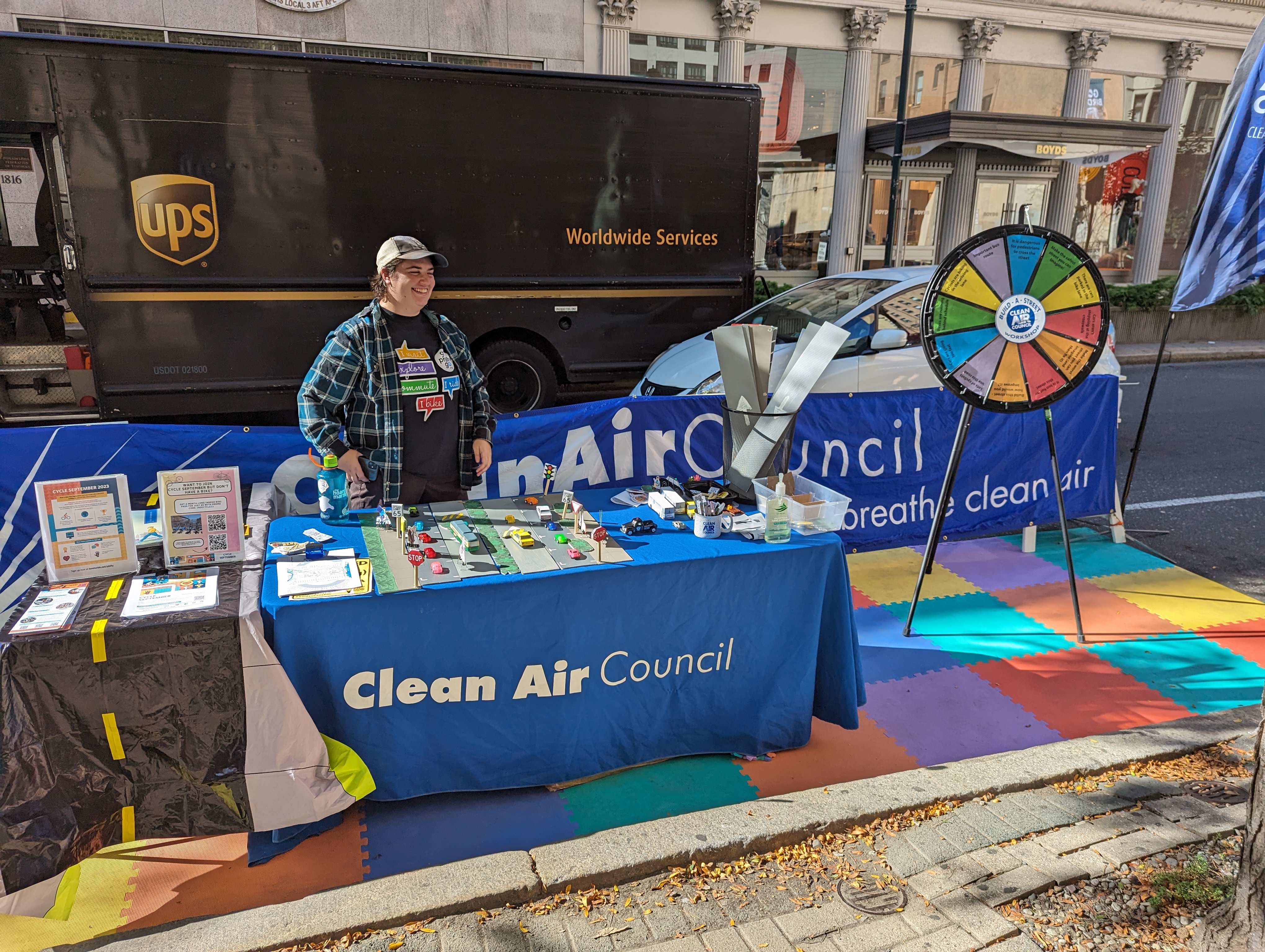
Learn how you can get a permanent parklet in your Philly neighborhood with this Feet First Philly Infographic, or contact Titania Markland, Transportation Outreach Coordinator to learn more about parklets and PARK(ing) Day at tmarkland@cleanair.org.
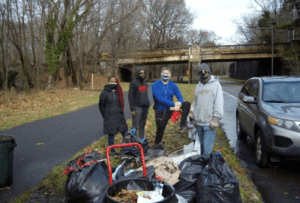
Philadelphia, PA (January 31, 2022)
This project/program was funded (in part) by the Pa. Department of Health’s Preventive Health and Health Services Block Grant.
Feet First Philly is Philadelphia’s only pedestrian advocacy group. The group is sponsored by Clean Air Council. For the second consecutive year, the Council and Feet First Philly partnered with the Philadelphia Department of Public Health to provide funding for neighborhoods to improve walkability in their communities. The projects awarded are located throughout Philadelphia and all seek to enhance public spaces.
This mini-grant program was created to allow community groups, residents, and even local businesses to become active in improving public spaces, by using community-led designs to improve safety and beauty. This program demonstrates ways in which a small amount of funding can have a big impact on neighborhoods when residents lead the effort. A historic lack of investment in public spaces in Philadelphia’s communities of color is a chronic problem, this mini-grant program prioritizes those neighborhoods that have historically been overlooked.
In the first year of the mini-grant program, Feet First Philly funded seven amazing projects. This year, over 60 residents, businesses, and community organizations submitted applications. Thanks to the city funds which were supplemented by our generous donors, the program will be able to support a total of nine mini-grants this year.
The projects selected will implement unique strategies to address different barriers to public spaces in their neighborhood. Feet First Philly recently announced the first 5 projects and will announce the additional four winners in the near future.
Cobbs Creek Ambassadors will expand its efforts in cleaning up the Cobbs Creek Trail. This year, the group “aims to establish a Trash, Trees, and Trails (T³) mission, a more holistic approach to engaging neighbors in the park’s revitalization.”
Norris Square Neighborhood will install community bulletin boards in front of two of their garden spaces to provide various information to neighborhood residents and create more welcoming spaces for neighbors to enjoy.
Southwest Community Development Corporation will create an outdoor space for community members to access and engage in various activities. This space will act as a pocket park for the neighborhood.
ACHIEVEability will increase safety, cleanliness, and neighborhood pride by beautifying the 60th Street Commercial Corridor between Arch and Chestnut Streets.
Hansberry Garden and Nature Center will enhance a meadow as a local walking destination with a welcome sign, seating area, and other amenities.
The additional four awardees will be announced soon. Follow Feet First Philly on Facebook, Twitter, and Instagram for updates on the additional projects!
For more information contact Titania Markland, Transportation Outreach Coordinator, tmarkland@cleanair.org.
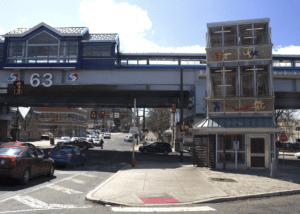
July, 5, 2021 – Communities identified by the Environmental Protection Agency (EPA) as Environmental Justice communities are more likely to experience issues that negatively impact pedestrian safety and result in higher rates of pedestrian fatalities from traffic crashes. According to PennDot, fatal or serious injuries from crashes are three times more likely to occur in low income communities and 30% more likely to occur in communities of color. These communities face real challenges to pedestrian safety including poor sidewalk conditions, lack of access to green space, and under funding for maintenance and safety enhancements.
Sidewalks are the foundation for walkability, and sidewalk condition is a major factor in deciding how people travel. Philadelphia has hundreds of miles of sidewalks in poor condition, with no concrete plan to fix them. The Council and its volunteer pedestrian advocacy group Feet First Philly work to improve the pedestrian environment in every neighborhood, protect the rights of pedestrians, and encourage walking as a mode of transportation, exercise, and recreation through public education, outreach, advocacy, and technical assistance to communities.
In 2020, Feet First Philly launched a sidewalk campaign to fund sidewalks like streets. Currently, homeowners are responsible for costly sidewalk repairs, which forms a barrier and liability for many residents who cannot afford to fix damaged sidewalks. Feet First Philly’s sidewalks campaign asks the city to set aside $500,000 to hire a full time sidewalks coordinator, conduct a sidewalk master plan, and create sidewalk repair funding strategy, as recommended by a 2018 Sidewalk Policy Transportation Community Development Initiative (TCDI) to the Office of Transportation & Infrastructure Systems.
Feet First Philly and the Council advocated for the sidewalk campaign through an op-ed in the Inquirer calling for the city to take action, by meeting with Councilmembers in preparation for budget season, and sending an action alert urging Mayor Kenney and City Council to fund sidewalks in the next budget. This spring, the Council and Feet First Philly joined 24 organizations advocating for Livable Communities budget requests, including dedicated funding for Vision Zero, transit, and sidewalks.
In addition to this budget campaign, the Feet First Philly Pedestrian Advocacy Guide connects people to city agencies and helps them navigate services to address safety concerns. Feet First Philly also developed two walk audit tools to engage residents, neighborhood leaders, students, and stakeholders to identify risks to pedestrians and connect residents to resources that can address these concerns.
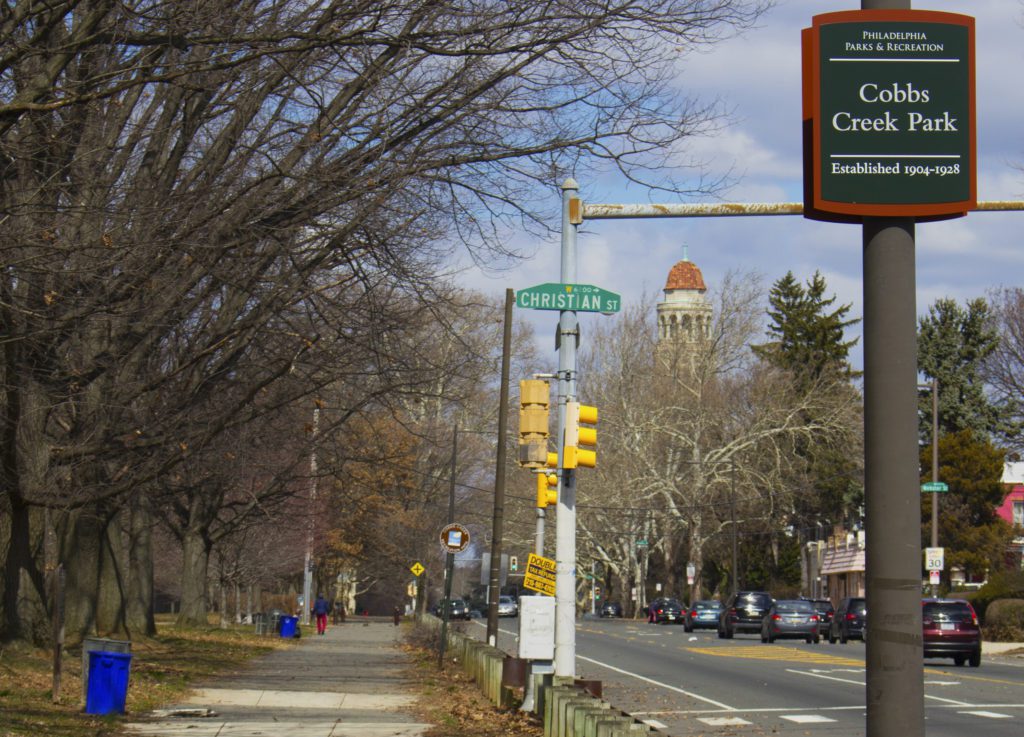
Highway design that prioritizes vehicle speed over pedestrian safety is a legacy issue that disproportionately affects communities of color in Philadelphia. Pedestrians accounted for just 7% of people involved in crashes from 2014 to 2018, but made up 40% of people killed in crashes during this period. Highly trafficked roads like Cobbs Creek Parkway make up the High Injury Network, the 12% of all Philadelphia roads that claim 50% of all traffic deaths and severe injuries.
For the past two years, the Council has connected residents, stakeholders, elected officials, and city agencies to work together to address the largest hurdle to accessing Cobbs Creek Park and Trail, which is the dangerous Cobbs Creek Parkway. The Parkway is a physical and mental hurdle for residents trying to access the park and connected trails and dangerous speeds, reckless driving, and lack of safe crossings are barriers that make the park and trail difficult and dangerous to visit. Tragically, the lives of three people were taken along the Parkway in the past year.
The Council partnered with Cobbs Creek residents to address their concerns and demand change. This resulted in the installation of speed hump and delineator posts. The Council continues to advocate for safety upgrades, and the City recently applied for funding to install new state of the art pedestrian crossings along Cobbs Creek Parkway. These would fill crossing gaps that stretch more than a mile and a half long and increase accessibility to this important trail and greenspace in one of the most dense areas of the city.
For more information contact Will Fraser, Transportation Project Manager, wfraser@cleanair.org
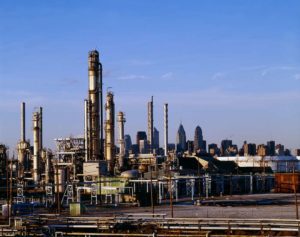
July 7, 2021 – The City of Philadelphia was one of the country’s first industrial hubs. While much of its large polluting industry has diminished over the years –there are some facilities that still emit toxic air emissions that impact public health and the environment. Generally federal, state and local governments have done a poor job of protecting public health from hazardous emissions that can cause cancer and other serious health problems. Yet we must come to grips with this most serious type of public health threat from air pollution. This is particularly true of communities that live in deep poverty and already suffer from poorer public health outcomes. The city of Philadelphia has more people living in deep poverty than any other large city in the United States.
Regulating toxic air pollution has proven to be particularly difficult to regulate since there is often no absolute safe level for an air pollutant that causes cancer or neurological damage. The only 100% safe solution would be to shut down all sources of toxic pollution from large factories, smaller industries such as dry cleaners and gas stations, and cars and trucks. Often the regulations of toxic air emissions are not based on the actual health threat but rather on what technology exists to lower emissions while still allowing the industry to operate.
The Council has long advocated that the city develop regulations to limit emissions of toxics based on public health impacts. The state and federal government should also. In Philadelphia air regulations are adopted by the city’s Air Pollution Control Board. (APCB). Air Management Services (AMS), a part of the Philadelphia Department of Public Health drafts the proposed regulations with input from city lawyers for review and adoption by the APCB.
In 2019, working with the APCB and groups like Clean Air Council, AMS announced that it would amend and strengthen its Air Management Regulation VI (AMR6) which regulated air toxics.
The proposed amended regulation would call for all new Title V (major source) permits and renewals to go through a risk screening process. If the risk from a particular pollutant went above a certain threshold it would trigger a risk assessment and the facility would have to show that it can lower its emissions and reduce harms to the impacted community in order to continue to operate in the City. If the facility could not properly do this, it would be denied its operating permit. It was a game changer. It is difficult for the city to adopt stronger regulations than the state or federal government for fear of making its businesses anti competitive. But both AMS and the APCB were interested in looking at this new approach to reducing air pollution risk in the City.
The Council has been actively pushing for such an approach to toxic pollution for many years. The proposal to amend AMR6 comes on the heels of New Jersey’s recent adoption of a similar law in late 2020. Pennsylvania should follow suit. This law requires that the New Jersey Department of Environmental Protection (NJDEP) to assess the public health and environmental risks that facilities renewing or amending licensing permits create for overburdened communities (low-income communities, communities of color, or communities with limited English proficiency).
The Council is pleased that Philadelphia is moving to better regulate the threat from toxic air pollution but is urging it to go further than what is proposed. The Council has urged the APCB and AMS to take up this opportunity to further decrease the risk thresholds and to look at the aggregate risk posed by multiple pollutants and multiple facilities so that it is more protective for the City’s residents, especially the most vulnerable — its children, elderly, and those with preexisting conditions.
The APCB has an opportunity to pass a regulation more protective than that of New Jersey and set a standard for Pennsylvania and large cities to follow.
For more information contact John Lee, Public Health Director, jlee@cleanair.org.
Along the Delaware River in the southern part of Delaware County refineries and incinerators have been poisoning the air for decades, negatively impacting residents’ health and quality of life.
On Saturday, June 26, residents of Chester, Marcus Hook, and surrounding Delaware County communities welcomed participants of the “Walk for Our Grandchildren” into their neighborhoods to draw attention to local environmental justice and public health issues. The Walk for Our Grandchildren included several dozen grandparents walking from Scranton, PA to Wilmington, DE over the course of a week to highlight the impact of the fossil fuel industry on local communities, and to call on the Biden administration to take stronger actions to address climate change.
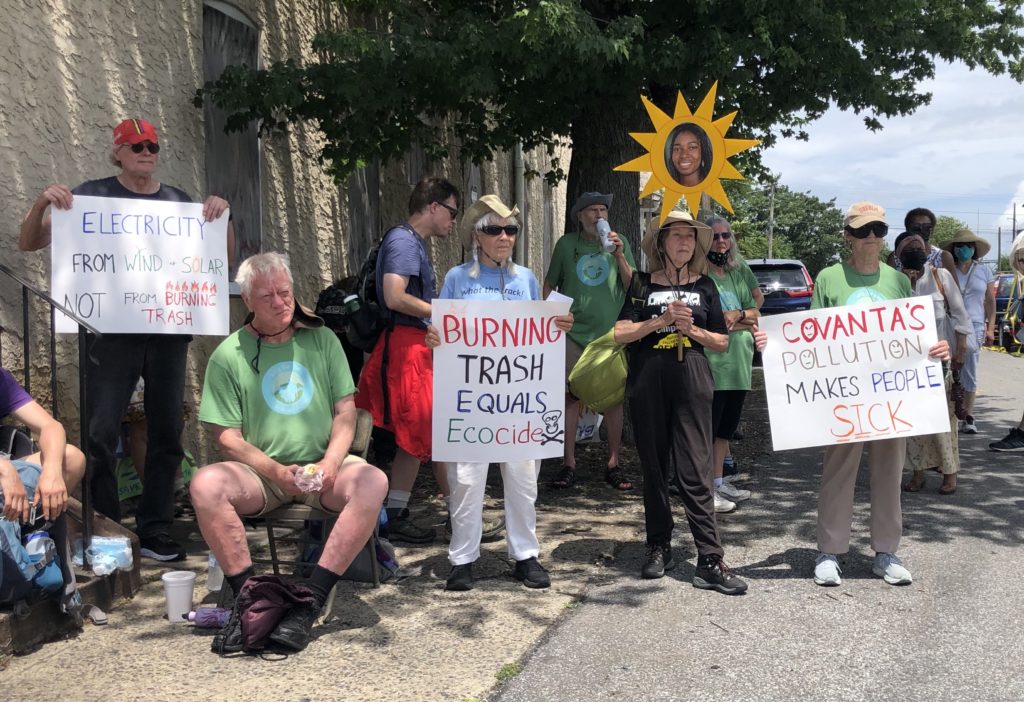
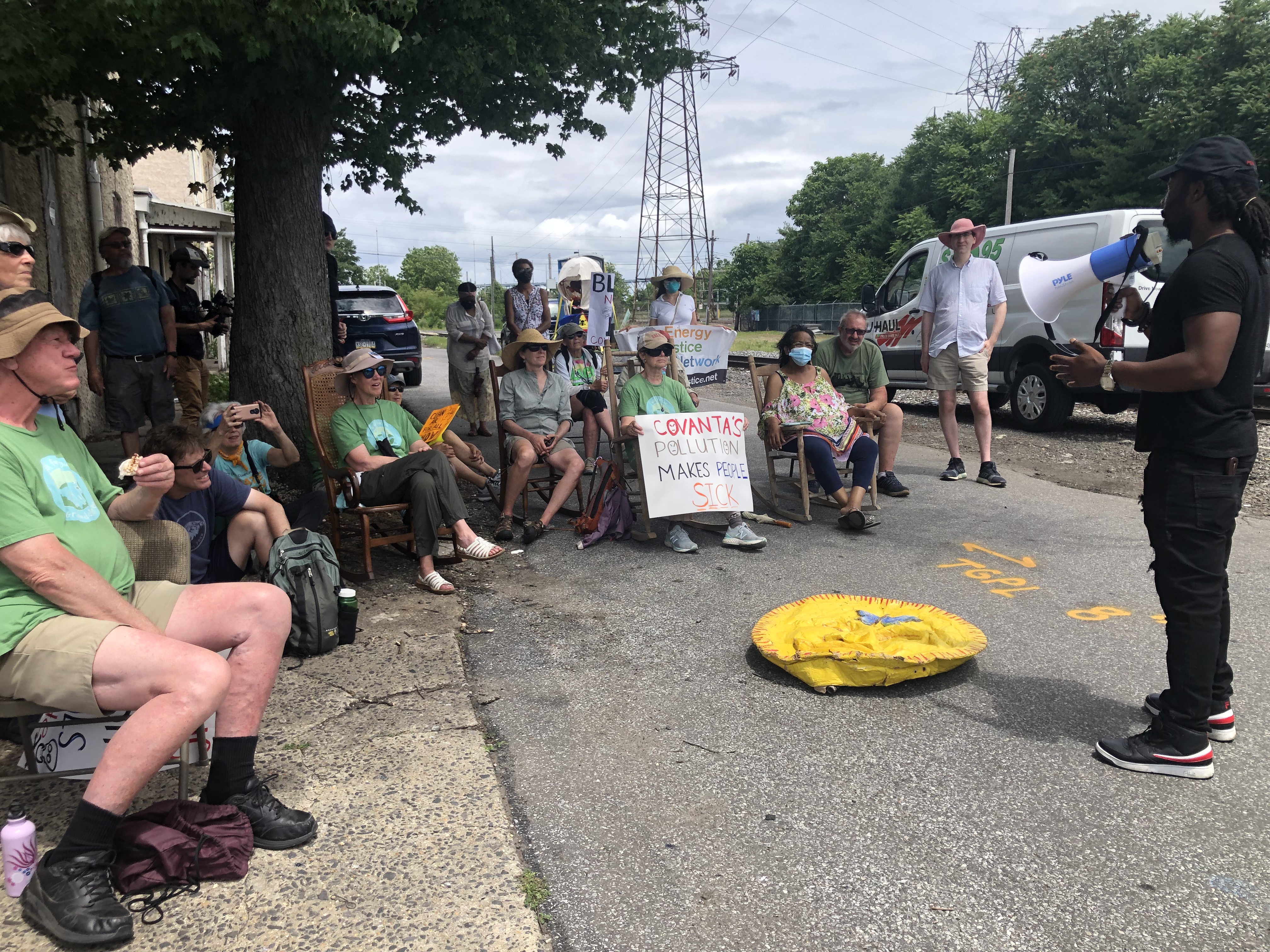
Members of the Chester Residents Concerned for Quality Living (CRCQL) group greeted the walkers at the gate to the polluting Covanta waste incinerator in Chester. There, community leaders from Chester shared their personal stories, including being forced to abandon their homes adjacent to the facility, the persistent noxious odors, and high rates of asthma, particularly among children. CRCQL leader Zulene Mayfield, who has been fighting environmental injustice in Chester for decades, shared the history of how the toxic Covanta facility was deliberately placed in Chester, a predominantly Black community.
“We welcome the support of the Walk for Our Grandchildren to highlight the issues that we have been facing here in Chester for years,” Zulene Mayfield stated, “The toxic Covanta incinerator is one of the most egregious examples of environmental racism in the country, and we call upon the Delaware County Council to end its contract with Covanta so that our children and families can breathe.”
The grandparents then traveled to Marcus Hook municipal park overlooking the Delaware River, where they had a clear view of the INEOS ships transporting ethane from the processing plant in Marcus Hook to Europe to be manufactured into single-use plastics.
Members of Marcus Hook, Trainer, and Chichester Residents for Public Health spoke to the many impacts to public health and safety that have resulted from the Sunoco / Energy Transfer Mariner East pipelines and the Marcus Hook Industrial Complex. Residents expressed a need for more information, education, and community wide awareness of the links between pollution and health impacts.
“Our fight in Marcus Hook is to make residents aware of the health issues and what they can do about them,” said local resident Lorraine Daliessio, “We have an Environmental Advisory Council made up of both residents and refinery representatives but many residents are not aware of the part they can play, or even that the EAC exists. We need awareness.”
Residents in both Chester and Marcus Hook, as well as surrounding communities such as Trainer and Upper and Lower Chichester bear the brunt of the pollution impacts from the refineries and incinerators along the Delaware River in the southern part of the County. In all of these communities, residents are holding out hope that the newly formed Delaware County Health Department will help to analyze the impacts of pollution on public health in these communities, and that change may finally come after decades of injustice and harm. The Clean Air Council has been supporting these community organizing efforts through our outreach, advocacy, and legal work.
Eve Miari, Advocacy Coordinator for Clean Air Council, added, “Residents in communities impacted by toxic air pollution are coming together and saying loudly and clearly, we have had enough. Enough environmental injustice, enough environmental racism, enough prioritization of private profit over public health. We have a right to clean air, pure water, and a healthy environment. We have the right to breathe.”
For more information contact Eve Miari, Advocacy Coordinator, emiari@cleanair.org
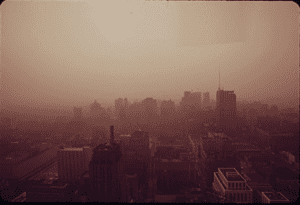
As I remember it — The Start of the Clean Air Council
I’ve been a Clean Air Council member since the nonprofit first began to fight for everyone’s right to breathe clean air. On a steamy late August day in the summer of 1967, I arrived at the University of Pennsylvania to start my graduate degree program in “Operations Research”. I had been accepted as a dorm proctor in the Upper Class Triangle Dorms at 37th and Spruce Streets and assigned a single dorm on the second floor, which had a screened window that looked out the back to a walkway. I had bought an Inquirer newspaper at a coin newspaper box and dropped the paper on the window sill, which was open to allow for a breeze.
After unpacking and traveling around campus to run my many errands, I returned late that afternoon exhausted and ready to eat my hoagie and read the Inky. I picked up the paper on the window sill and was astonished to see the black newsprint on the front page slide right off the page! This illusion was caused by a layer of fine black soot, likely air particulate matter, in the air that deposited through the window screen over roughly 5 hours and landed on the newspaper. I was astounded and concerned that I had been breathing this same air all day!
Black soot and fine particulate matter is a public health problem that kills millions of people each year. As someone concerned about air quality and the environment, I was a regular contributor and member of the American Lung Association. I learned they had initiated another independent health group to promote clean air. The group would work to fight air pollution in the Philadelphia area. This was before the first Earth Day and before national legislation such as the Clean Air Act was passed.
They invited the public to attend the first meeting. Given my concern for the sooty air I was breathing since moving into the city, I made it a point to be at this meeting.
The meeting had about 25 attendees. The meeting chair was from the Lung Association of Chester County. The Chair specifically noted they were not turning on the overhead fluorescent lights and only using the ambient light from the windows and the room was not air conditioned but it felt quite comfortable. There were two brothers, one a professor in communications at Temple, the other a well known Philadelphia personality/news host for a major local TV channel. It was the latter who was initially chosen to lead this new group called the Clean Air Council.
I’m proud to be a Clean Air Council member 54 years later and contribute to defending everyone’s right to a healthy environment.
By longtime Clean Air Council member, James Castellan.
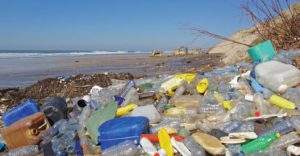
Plastics are slowly killing life on earth. We enjoy the convenience of plastics but delude ourselves that we can dispose of them safely. We give little thought to the damage done to the environment and to public health that results from extracting the fossil fuel needed to produce and manufacture plastics. We worry about climate change but stubbornly do not make the connection between plastic production and emissions of greenhouse gases. Most people falsely believe that recycling plastics is the answer — even though the vast majority of plastics can not be recycled and there is no real market for recycled plastics. Most of us will remember that distressing video of a sea-turtle with a plastic straw stuck in its nose. That’s happening every day. Plastics don’t really break down, they turn into dangerous microplastics that we’re now consuming.
Plastics are everywhere — some are necessary, many are not. Food wrappers, cigarette filters, single-use plastic bags, plastic straws, styrofoam.
The easiest plastics to avoid are the single-use plastic items we use for convenience or out of habit. As residents, we pay a high financial cost for single-use plastics. The City of Philadelphia spends between $9 million and $12 million every year cleaning plastic bags from the streets, sewers, and bodies of water. Philadelphia alone uses approximately one billion plastic bags per year, many of which end up as litter in our neighborhoods. Pennsylvania taxpayers spend over $13 million every year just cleaning up roadside litter. This money should be spent on more important things such as public education.
The plastic and petrochemical industry mislead the public by marketing plastics as “recyclable” when in reality, less than 9% of all plastic ever produced has been recycled. There is no viable solution for plastic waste. According to the United Nations Environment Programme, 12% of plastics are burned in incinerators (increasing air pollution in communities of color where waste incinerators are typically located) and 79% of plastics are deposited in landfills, dumps or end up in the natural environment.
Nearly all plastics produced derive from oil, fracked gas, and coal — dirty, non-renewable resources. Plastics and the climate crisis go hand-in-hand: plastic production depends on fossil fuels, and fossil fuels rely on plastic production.
Another hidden cost to single-use plastics: human health. For instance, Royal Dutch Shell’s 386-acre ethane cracker—built to make plastics— is set to power up this year about 25 miles outside of Pittsburgh in Beaver County. Shell’s plant will release 159 tons per year of fine particulate matter and 522 tons per year of volatile organic compounds (VOC), according to the Council’s 2014 Health Impacts Assessment. VOCs exacerbate health conditions including asthma, cardiovascular disease, cancer, endocrine disruption, and adverse birth outcomes.
There are also terrifying new links being made between microplastics and other toxins. Scientists are finding that microplastics accumulate toxins like DDT and PCBs from trace levels that may already exist in the environment, and deliver them to wildlife and humans that eat them, often bioaccumulating through the food chain.
The Council spent more than 10 years advocating to pass a Philadelphia single-use plastic bag ban. However, Philadelphia’s plastic bag ban was delayed one year due to COVID-19 and will now go into effect on July 1, 2021.
The Council advocates for turning off the “plastics tap,” and is fighting legislation that would limit local government’s ability to regulate single-use plastic items. Representing Pennsylvania residents in court, the Council joined the City of Philadelphia, Borough of West Chester, Borough of Narberth, Lower Merion Township, and the City of Pittsburgh in a lawsuit to overturn the state’s unconstitutional preemption of municipalities from enacting or enforcing single-use plastic legislation. The Council is fighting for local residents and leaders to implement sustainable solutions locally to plastic pollution.
It’s time to end our addiction to plastic, enact local solutions, and choose to protect the environment over convenience. Start by ditching single-use plastics for Plastic Free July and spreading the word about plastic pollution.
Written by Jessica Bellwoar, Development Officer, jbellwoar@cleanair.org. For more information on the PA Plastics Preemption lawsuit contact, Logan Welde, Staff Attorney, lwelde@cleanair.org.
Tags: Plastics, recycling, waste, zero waste, litigation

- Where are you from and what’s your background?
I grew up down at the shore in South Jersey. Growing up at the beach gave me a unique appreciation for nature and our environment. From an early age, I was involved in beach clean ups and even adopted a seal from the Marine Mammal Stranding Center in Brigantine, NJ. I was raised in a household where voting and taking action for causes you care about mattered. I was an environmental activist from a young age.
- What’s your role with the Council?
I’m the Communications Director. My role is exciting and allows me to play a part in all of the Council’s work. From social media, to press, to marketing
- How long have you been with the Council?
I started at the Council as a Development Intern in 2006. My current position as Communications Director truly encompasses all aspects of my responsibilities throughout the years and I’m excited to improve the way we communicate with the public. You may even see us on TikTok soon.
- What’s kept you motivated and invested all these years in the environmental movement?
The environmental movement is always growing and changing to become more effective. I’m constantly learning new tactics to be a better advocate and share our work with the public. This keeps me on my toes. With the climate crisis being the largest existential threat to our society, there has never been a more important or exciting time to be working in environmental advocacy. Communications strategies are always changing and I need to stay on top of them for the Council to remain effective.
- How can social media help advance climate solutions?
Social media is a critical tool for advocacy. It can be used to disseminate information, hold elected officials accountable, and organize communities. The Council has begun to provide “Social Media for Advocacy” training for the impacted communities that the Council works with. These trainings are one of the best parts of my job. I get to see people newly armed with communications tools to use to protect their health and environment.
- What’s the biggest challenge in communicating critical news the Council’s members or the public at large?
The news can seem like a lot of doom and gloom. It’s important for people to see positive stories to balance out all of the negativity. It’s always a challenge for us to stand out in people’s newsfeeds or inboxes. Again (shameless plug), that is why it is so important for people to follow the Council on social media and open our email newsletters so that they can see the good work and victories that we have accomplished. The Council also regularly shares very important ways for you to get involved with our organization and take actions to protect the environment.
Thanks Katie for everything you do for the Council!
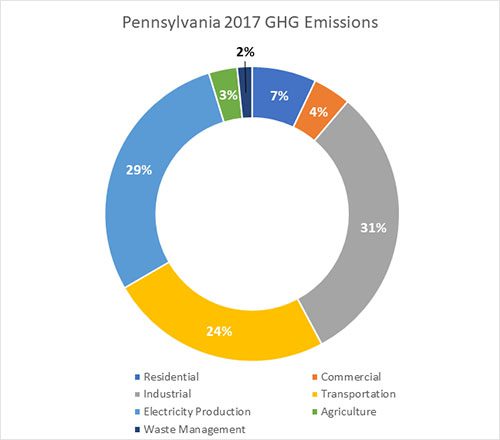
The Path to Deep Decarbonization in Pennsylvania
July 6, 2021– The climate crisis is accelerating and intensifying. An alarming new analysis released in mid-June by NASA and NOAA found that the planet is trapping roughly double the amount of heat in the atmosphere that it did just 15 years ago. We know that climate tipping points could trigger other climate tipping points in a domino effect, leading to irreversible impacts. Earth has already warmed roughly 1.1 degrees Celsius since the 19th century. Even if we magically zeroed out all greenhouse gas (GHG) emissions tomorrow, that warming is baked in for decades. Thankfully, we have the tools available to save lives and prevent the worst impacts from being felt. But we need to enact sweeping policy changes now and over the course of this decade to make that happen.
In Pennsylvania, historically a major fossil fuel state, key sources of GHG pollution can be broken down into these categories:
- electricity generators (coal-fired and fracked gas-fired power plants);
- industrial activities (e.g., fracked gas extraction and processing, iron and steel production, cement manufacturing);
- transportation sources;
- residential and commercial buildings, and
- agriculture
To oversimplify things, here’s a two-step path to dramatically curb emissions: (1) decarbonize the electricity sector; and (2) then electrify everything. There will be countless complementary policy measures needed to implement that plan (and not everything can be easily electrified) but it’s a solid framework to guide our efforts.
To help decarbonize Pennsylvania’s electric sector, Governor Wolf directed the Department of Environmental Protection (PADEP) to draft rules to establish a CO2 Budget Trading Program and allow the Commonwealth to participate in the Regional Greenhouse Gas Initiative (RGGI) beginning in 2022. RGGI is a collaborative effort between 11 neighboring states that uses a market-based auction approach to put a price on carbon for polluting power plants. RGGI states have seen their power sector carbon pollution cut in half since 2009. PADEP projects that RGGI participation will cut up to 227 million tons of CO2 by 2030, while generating hundreds of millions of dollars in annual proceeds for reinvestment in Pennsylvania businesses and communities. This is a strong first step.
Pennsylvania would also benefit from President Biden’s proposed Energy Efficiency and Clean Electricity Standard (EECES) – which aims to fully decarbonize America’s electricity sector by 2035 – and by the U.S. Environmental Protection Agency’s (EPA) plans to reinstate a strengthened version of President Obama’s Clean Power Plan. In March, Governor Wolf also announced a major public-private partnership (called “PULSE”) to install seven new solar arrays in counties across Pennsylvania that will supply nearly half the electricity used by state government. This project will go into operation beginning January 1, 2023, and represents the largest commitment to solar energy by any government in the U.S. That’s a decent start for the electricity sector.
Pennsylvania also needs to significantly invest in expanding our electric vehicle (EV) charging infrastructure and accelerate consumer knowledge and adoption of EVs. In February, PADEP announced it intends to promulgate a proposed Zero Emission Vehicle (ZEV) rulemaking later this year, which would require automakers and dealerships in Pennsylvania to sell a certain amount of electric cars and trucks. However, it’s not enough to simply change motors in the vehicles we drive. We need to incentivize transportation mode shifting by making substantial investments in public transit, railways, bike trails, and walkable corridors in our cities and suburbs.
On the industrial side, Pennsylvania is the second-largest fracked gas producing state in the country. Our gas industry emits over 1.1 million tons of methane pollution every year. Methane, the primary component of fracked gas, is an extremely potent climate pollutant and leaks across every stage of the gas supply chain. PADEP is finalizing a rulemaking to control methane emissions from existing infrastructure (well sites, compressor stations, and processing plants), but the proposal currently exempts so-called “low-producing” wells from routine inspection requirements. In practice, this means over half the methane emissions from existing sources will continue to go unchecked. Clean Air Council helped deliver tens of thousands of comments during the public comment period last year urging PADEP to close this loophole.
The Biden EPA is also planning to draft federal methane rules for existing sources, which we anticipate seeing introduced as early as September 2021. Those have enormous potential to reduce Pennsylvania emissions. So too would the $16 billion called for by President Biden in his American Jobs Plan to plug orphaned wells and clean up abandoned mine lands. Pennsylvania has hundreds of thousands of orphaned gas wells (the vast majority of which aren’t even documented) that desperately need funding to plug up methane that’s been leaking for decades.
Finally, about 11% of Pennsylvania’s GHG pollution comes from burning fossil fuels to heat space and water in our residential homes and commercial buildings. In Philadelphia, our building stock contributes more than 70% of the city’s GHG emissions. We need to move quickly to incentivize all-electric construction in new buildings, while taking bold steps to retrofit and electrify our existing buildings. This can happen at the municipal level, where Philadelphia is conducting a Diversification Study to examine the future of Philadelphia Gas Works, the nation’s largest municipally owned fracked gas utility. It can also happen at the federal level, where another key component of President Biden’s American Jobs Plan would invest billions in retrofitting our nation’s homes and buildings.
Clean Air Council has been directly involved in all the various legal and policy issues surrounding these plans in the past year. There is so much that needs to happen and quickly. Thankfully, we have a solid grasp on how to reach our goals and these multifaceted efforts should work in tandem to drive down emissions. It’ll be the challenge of our lifetimes, and it’s already begun.
For more information, please contact:
Robert M. Routh, Esq.
Public Policy and Regulatory Attorney
rrouth@cleanair.org
HARRISBURG, PA (June 30, 2021) We celebrated a big victory in mid-June with a court ruling that restored the rights of people across Pennsylvania to challenge fracked gas projects that threaten their health and their environment! Residents of Upper Bucks County and a local municipality, West Rockhill Township, had appealed a decision of the Pennsylvania Department of Environmental Protection granting an air pollution permit to the Adelphia Gateway Pipeline project for its Quakertown Compressor Station. The Adelphia Gateway Pipeline is a gas pipeline cutting through the Lehigh Valley and the Philadelphia suburbs. Compressor stations are large, polluting facilities that push the gas along the pipeline to its destination.
The Pennsylvania Environmental Hearing Board (EHB) had thrown out the appeals, saying that it didn’t have a right to hear them, and that only federal appeals courts could hear challenges to projects that are part of interstate gas pipelines. But the EHB is designed to make it simple for everyday people to file appeals. At the EHB, parties can bring new evidence to the judges and have a trial on the new evidence. Challenges to these projects in federal court can be more complicated and don’t allow the parties to put on new evidence and have a trial. The EHB decisions had kept the township and the residents from getting their day in court and threatened to keep other people from being able to exercise their rights to appeal harmful projects, too.
With Clean Air Council’s help, the parties appealed the EHB’s decisions to the Pennsylvania Commonwealth Court. The Commonwealth Court reversed the decisions, agreeing that federal law dealing with interstate gas pipelines did not conflict with state law giving people the right to take their appeals to the EHB. The residents and the township can now move ahead with their cases at the EHB challenging the dangerous Quakertown Compressor Station, and all Pennsylvanians’ rights have been protected!
For more information contact Alex Bomstein, Senior Litigation Attorney, abomstein@cleanair.org

